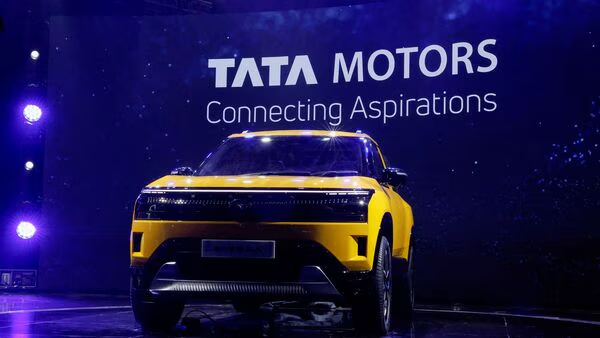In a significant restructuring move, Tata Motors Ltd has officially completed its long-awaited demerger, effective October 1, 2025. This strategic separation marks a new chapter for India’s largest automaker, splitting its business into two distinct entities — one focusing on commercial vehicles (CVs) and the other on passenger vehicles (PVs), including the Jaguar Land Rover (JLR) business.
The demerger is part of Tata Motors’ broader plan to unlock shareholder value, sharpen business focus, and enhance operational agility across both divisions.
🔹 What the Tata Motors Demerger Means
Under the approved composite scheme of arrangement, Tata Motors’ commercial vehicle division has been transferred to TML Commercial Vehicles Limited (TMLCV). Meanwhile, its passenger vehicle operations, including Tata Passenger Electric Mobility and the JLR unit, will continue under the parent company — which is being renamed Tata Motors Passenger Vehicles Limited (TMPVL).
This restructuring allows both arms to pursue independent strategies — the commercial vehicle business focusing on logistics, trucking, and electric buses, while the passenger vehicle division strengthens its EV and luxury mobility portfolio.
📅 Tata Motors Demerger Record Date & Entitlement Ratio
Tata Motors has fixed October 14, 2025, as the record date for the demerger.
Shareholders holding Tata Motors stock as of this date will be eligible to receive shares in the newly formed TML Commercial Vehicles Ltd.
The share entitlement ratio is 1:1, meaning:
For every one Tata Motors share held, investors will receive one fully paid-up share of ₹2 face value in TMLCV.
This ratio ensures equitable distribution and provides investors direct exposure to both Tata’s high-growth segments — commercial and passenger vehicles.
📈 Listing and Market Debut
The newly formed TML Commercial Vehicles Ltd is expected to be listed on both BSE and NSE in early November 2025.
After listing, both Tata Motors Passenger Vehicles Ltd (TMPVL) and TMLCV will trade as independent companies, enabling investors to evaluate and invest based on their preferred segment exposure.
⚙️ Management Reshuffle: New Leaders for Each Arm
Ahead of the demerger, Tata Motors announced a key leadership restructuring to ensure a smooth transition:
- Girish Wagh will lead TML Commercial Vehicles Ltd as Managing Director & CEO.
- Shailesh Chandra will head Tata Motors Passenger Vehicles Ltd, continuing his role as MD of Tata Passenger Electric Mobility Ltd.
Both leaders bring deep industry expertise, having steered Tata’s turnaround in their respective divisions over the past few years.
🚘 Sales Performance: Strong Growth Momentum
Despite market volatility, Tata Motors continues to deliver strong sales performance across segments.
- Commercial Vehicles (CVs): Sales rose 19% YoY in September 2025 to 35,862 units, supported by demand for heavy and intermediate trucks.
- Passenger Vehicles (PVs): Tata Motors achieved its best-ever monthly passenger vehicle sales, selling 60,907 units, up 47% YoY, driven by festive season demand and robust EV adoption.
This growth reinforces Tata’s position as a leader in India’s automotive transformation, especially in the EV space.
💬 Expert Opinions: Value Unlocking in Focus
Market experts believe the Tata Motors demerger will unlock hidden value within the company and attract fresh investor interest.
According to analyst Avinash Gorakshakar, both entities are poised for long-term gains despite short-term volatility:
“In the near term, Tata Motors shares may remain subdued due to external factors like the cyberattack and weak Q2FY26 earnings outlook. However, the demerger provides a strong long-term structural story. Investors can consider accumulating the stock on dips for potential alpha in the next 12–18 months,” he noted.
Gorakshakar further added that JLR’s business could command a premium valuation due to its profitability and global brand equity, while domestic CV and PV businesses are expected to see steady scalability.
📊 Market Reaction: Tata Motors Shares End Lower
Despite strong trading volumes early in the session, Tata Motors’ share price closed 0.27% lower at ₹716.20 apiece on October 3, 2025, underperforming both Sensex and Nifty 50.
The dip followed profit booking after a recent rally that took the stock close to its 52-week high of ₹950.30.
💡 Why the Demerger Matters for Investors
The Tata Motors demerger is more than a corporate restructuring — it’s a strategic reset for the future of India’s mobility sector.
Here’s why it’s significant:
- Sharper Focus: Each entity can now make independent decisions aligned with its unique business goals and market opportunities.
- Transparency for Investors: Separate balance sheets for CV and PV businesses improve visibility into financial performance.
- Potential Value Unlock: Investors can hold or trade shares based on their confidence in specific sectors — EV growth or commercial logistics.
- Enhanced Flexibility: Both companies can raise capital, form partnerships, and innovate without cross-divisional constraints.
With the upcoming listing of TMLCV, investors will soon have a clearer picture of the market valuation for each arm — a move that’s expected to enhance overall shareholder wealth.
🏁 The Road Ahead
As Tata Motors enters its next growth phase, the company’s twin focus on sustainable transportation and mobility innovation aligns perfectly with India’s push toward green and electric vehicles.
The demerger is expected to accelerate this journey by empowering both divisions to innovate faster, execute independently, and respond better to global market dynamics.
With strong fundamentals, visionary leadership, and a rapidly expanding EV portfolio, Tata Motors’ split could well become a template for corporate value unlocking in India’s auto industry.
